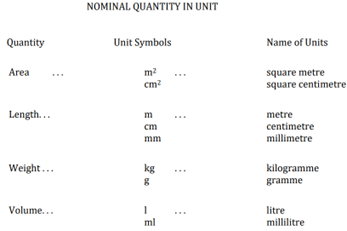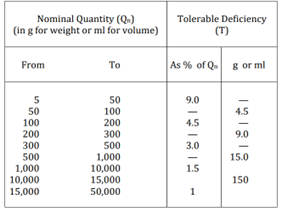Quantity Declaration and Marking Requirements to be Tightened from 4 June 2024
25 October 2023
On 21 September 2023, the acting Minister of Domestic Trade and Cost of Living has made the
Trade Descriptions (Marking of Quantity for Pre-packaged Goods) Order 2023 [P.U.(A) 296/2023] (“
New Marking Order”).
This New Marking Order was gazetted on 2 October 2023, and is intended to take effect on
4 June 2024 to replace the
Trade Descriptions (Marking of Pre-packaged Goods) Order 2023 [P.U.(A) 197/2023] (“
Existing Marking Order”) which is currently in force. Our write-up on the Existing Marking Order can be accessed
here.
Whilst the New Marking Order has retained most provisions in the Existing Marking Order, for example the provisions on application, mark legibility, tolerable deficiency, sample testing and penalties, however, there are few notable changes surrounding the provision for marking of pre-packaged goods, including certain definitions.
Quantity declaration and marking requirements for pre-packaged goods
The provisions in paragraphs 3 and 4 of the Existing Marking Order have been revised and re-arranged into paragraphs 4 and 5 of the New Marking Order, where:
- the definition for “package” has been shortened and revised to mean “anything in which or by which goods is wholly or partly cased, covered, closed, contained, or placed or otherwise packed in any way whatsoever”;
- paragraph 4 of the New Marking Order has absorbed the definitions in the Existing Marking Order for “pre-packaged goods”, “weight”, “count”, volume”, “area”, and “length”, and stipulates that the wholesaler, manufacturer, importer or producer shall declare the quantity of the goods in a package according to the following measurements: (1) area in two dimensional figure; (2) number based on actual count; (3) length from end to end; (4) weight from five grammes to fifty kilogrammes; and (5) volume from five millilitres to fifty litres;
- the New Marking Order has omitted paragraphs 4(1)(a) and 4(1)(d) of the Existing Marking Order;
- paragraph 5(1) of the New Marking Order has combined paragraphs 4(1)(b) and 4(1)(c) of the Existing Marking Order, and stipulates that the wholesaler, manufacturer, importer, or producer shall ensure all declared pre-packaged goods have been marked with: (1) nominal quantity as specified in Part I of the First Schedule (see figure below); and (2) specified quantity indicator count expressed in numbers according to Part II of the First Schedule (i.e. that the quantity indicator shall be expressed in numbers);

- paragraph 5(2) of the New Marking Order is similar to paragraph 4(2) of the Existing Marking Order, where it requires any pre-packaged goods containing solid goods in liquid medium to be marked with, either: (1) the nett weight and drained weight declared if the liquid medium is meant to be left over after use or in a situation where it might or might not be left over after use; or (2) only the nett weight declared if the liquid medium is not meant to be left over after use. For this purpose, the nett weight refers to the total weight of solid goods and liquid medium in a package, whilst drained weight refers to the weight of solid goods in the liquid medium contained in a package; and
- paragraph 6 of the New Marking Order provides that the mark referred in paragraph 5 shall:
- be legible;
- use clear words in:
- the national language or the national language and any other language if the goods originated from Malaysia; or
- the national language or English language if the goods originated from outside Malaysia;
- be stamped or printed in colour which provides clear contrast with the background colour of the goods; and
- have a minimum height between two to six millimetres according to the specification in the Second Schedule.
Tolerable Deficiency
Whilst paragraph 7(1) of the New Marking Order stipulates that the average value of the actual quantity determined in the sample pre-packaged goods inspected shall not be less than the nominal quantity, there are also provisions for tolerable deficiency in other parts of paragraph 7.
For this purpose, tolerable deficiency means the acceptable deficit in the quantity of goods in a package, actual quantity means the nett quantity of the goods after inspection, and nominal quantity means the quantity declared by manufacturer, importer, producer or wholesaler of the goods excluding the package and any other material packed along with the goods.
Paragraphs 7(2), 7(3), 7(4) and 7(5) of the New Marking Order provide that:
- for any goods declared in weight or volume, no pre-packaged goods shall have a negative error greater than twice the tolerable deficiency specified in the Third Schedule (see figure below), notwithstanding Part I of the Fourth Schedule has sampling allowance for goods with negative error greater than the tolerable deficiency;

- in cases involving drained weight, the pre-packaged goods shall not have a negative error greater than twice the tolerable deficiency as specified in the Third Schedule;
- for pre-packaged goods declared in length, the tolerable deficiency allowed shall be two percent of the nominal quantity for each package;
- for pre-packaged goods declared in area, the tolerable deficiency allowed shall be three percent of the nominal quantity for each package; and
- in cases where the pre-packaged goods are declared in counts, the actual quantity shall not be less than the nominal quantity for counts up to fifty. For counts which is more than fifty, the actual quantity shall not be less, on average, of the nominal quantity and the negative error is one piece for each of the beginning hundred.
Non-conforming packages in testing sample
The Fourth Schedule of the New Marking Order provides for the allowance of goods from the sample taken for testing that has a negative error greater than the tolerable deficiency, as well as the testing methods on the pre-packaged goods sample by the Assistant Controller of Trade Descriptions.
Penalties
A wholesaler, producer, manufacturer or importer who contravenes any provision of the New Marking Order commits an offence and shall, upon conviction, be liable to the following.
- If a body corporate, a fine not exceeding RM200,000 for the first offence, or a fine not exceeding RM500,000 for a second or subsequent offence; or
- If a non-body corporate, a fine not exceeding RM100,000 or imprisonment for a term not exceeding three years or to both for the first offence, and for a second or subsequent offence, a fine not exceeding RM250,000 or imprisonment for a term not exceeding five years or to both.
Revocation and Savings
Paragraph 10 of the New Marking Order provides for revocation of the Existing Marking Order on 4 June 2024. Notwithstanding the coming into operation of the New Marking Order, paragraph 11 provides that any investigation, prosecution, or proceedings in respect of the Existing Marking Order or pending under the Existing Marking Order may be continued.
Conclusion
The revision and re-arrangement brought about by the New Marking Order have to some degree tightened the provisions for quantity declaration and marking requirements for pre-packaged goods. For example, in the Existing Marking Order, there is no express obligation for wholesaler, manufacturer, importer or producer to declare the quantity of pre-packaged goods in a package. This is now expressly provided for in paragraph 4 of the New Marking Order.
However, similar to the situation faced under the Existing Marking Order, it would be helpful if the Ministry of Domestic Trade and Cost of Living could further clarify whether the provisions of the New Marking Order are applicable only to goods packaged, manufactured or produced in, or imported into, Malaysia from 4 June 2024 or also to goods that have been packaged and marked under the Existing Marking Order before 4 June 2024. Also, technical guidance from the Ministry may be needed to assist market players, especially micro, small and medium size enterprises who are wholesalers, manufacturers, importers, or producers, to comply with the New Marking Order.
Article by Joshua Teoh Beni Chris (Partner) of the Product Law Practice of Skrine.
This alert contains general information only. It does not constitute legal advice nor an expression of legal opinion and should not be relied upon as such. For further information, kindly contact skrine@skrine.com.